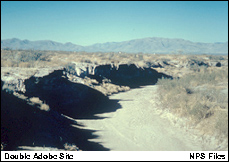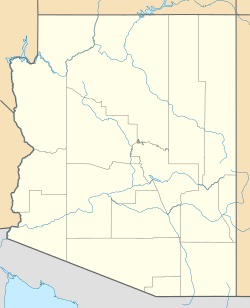Double Adobe Site facts for kids
|
Double Adobe Site
|
|
 |
|
| Nearest city | Douglas, Arizona |
|---|---|
| NRHP reference No. | 66000169 |
Quick facts for kids Significant dates |
|
| Added to NRHP | October 15, 1966 |
| Designated NHL | January 20, 1961 |
The Double Adobe Site is a very important archaeological site in southern Arizona. It's located about twelve miles northwest of Douglas. This area is known as the Whitewater Draw. The site helps us understand how people lived thousands of years ago.
Contents
Discovering the Double Adobe Site
In October 1926, a big discovery was made at the Double Adobe Site. This happened just a few months after the first human artifact was found at the Folsom Site. Byron Cummings, who was the first head of the Archaeology Department at the University of Arizona, led a team of four students to the Whitewater Draw area.
A schoolboy actually found the Double Adobe site. Inside, they found the skull of a mammoth. This skull was lying on top of a layer of sand. This sand layer also contained ancient stone tools. One of the students on this important trip was Emil Haury, who later became a very famous archaeologist.
What They Found
Later, other scientists studied the site more closely. They discovered that the bones and tools had been moved around by ancient stream sediments. This made it a bit tricky to understand everything at first.
However, many amazing things were still found. They discovered fossil bones from huge animals like mammoths, horses, bison, antelope, coyotes, and even dire wolves. These bones were found together with human-made tools. The tools included rocks cracked by fire, sharp projectile points (like arrowheads or spear tips), and small grinding stones.
Life After the Ice Age
The discovery of grinding stones at the Double Adobe Site is very important. It suggests that people were starting to change how they lived. This was happening as the last Ice Age was ending. Many large animals, like mammoths, were also starting to disappear.
The world was getting warmer and drier. This new period, called the Holocene Era, began about 10,000 years ago. In the Southwest, the warmer conditions meant that the Clovis culture began to change. Around 11,000 to 10,500 years ago, new ways of life appeared. These are generally called the Archaic cultures.
The Cochise Culture
In 1941, archaeologists E. B. Sayles and E. Antevs defined something called the Cochise culture. This name was given to the southern Archaic way of life in the Southwest. Their definition was based on the discoveries made during excavations in the Double Adobe district.
Many respected archaeologists have studied this region over the years. The Double Adobe Site has provided very important information. It helps us learn about the prehistoric climate, the ecology (how living things interact with their environment), and the animal life in southern Arizona long ago.
Why This Site Matters
Because of its great importance, the Double Adobe Site was declared a National Historic Landmark in 1961. This means it's a place of special historical value to the United States.



